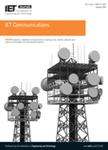版权所有:内蒙古大学图书馆 技术提供:维普资讯• 智图
内蒙古自治区呼和浩特市赛罕区大学西街235号 邮编: 010021

作者机构:Zhejiang Univ Technol Coll Informat Engn Hangzhou Zhejiang Peoples R China Xidian Univ State Key Lab Integrated Serv Networks Xian 710071 Shaanxi Peoples R China Zhejiang Univ Dept Informat & Elect Engn Hangzhou Zhejiang Peoples R China
出 版 物:《IET COMMUNICATIONS》 (IET通信)
年 卷 期:2018年第12卷第19期
页 面:2429-2437页
核心收录:
基 金:National Natural Science Foundation of China Zhejiang Provincial Natural Science Foundation of China [LR17F010002, LR16F010003] Young Talent Cultivation Project of Zhejiang Association for Science and Technology [2016YCGC011]
主 题:cellular radio 5G mobile communication interference suppression radio spectrum management telecommunication traffic bandwidth allocation multi-access systems resource allocation wireless channels cochannel interference concave programming resource optimisation downlink nonorthogonal multiple access systems joint channel bandwidth ultra-high throughput massive connectivity 5G cellular systems frequency channel successive interference cancellation spectrum efficiency limited spectrum resources crowded spectrum resources NOMA transmission joint optimisation scheme transmit-power allocations NOMA-enabled downlink transmission resource consumption cost spectrum consumption cost power consumption cost joint optimisation problem equivalent bandwidth optimisation problem optimal bandwidth allocation NOMA-enabled transmission conventional OMA-based transmission power allocation approach co-channel interference mitigation nonorthogonal multiple access mobile users MU traffic requirements nonconvex optimization
摘 要:The emerging non-orthogonal multiple access (NOMA) has been considered as a promising scheme to reach the goals of 5G cellular systems. By enabling a group of mobile users (MUs) to share a same frequency channel and adopting the successive interference cancellation to mitigate the co-channel interference, NOMA can improve the spectrum efficiency compared with the orthogonal multiple access (OMA). This study proposes a joint optimisation scheme of the channel bandwidth and the transmit-power allocations for the NOMA downlink transmission, which aims at minimising the overall resource consumption cost including both the spectrum consumption and the power consumption, while satisfying the MUs traffic requirements. In spite of the non-convexity nature of the joint optimisation problem, this study characterises the connection between the channel bandwidth and the associated transmit powers for the MUs. Based on this connection, this study transforms the joint optimisation problem into an equivalent bandwidth optimisation problem, and further proposes an efficient algorithm to compute the optimal bandwidth allocation (which enables us to derive the corresponding transmit powers for the MUs). Extensive numerical results are provided to validate the proposed algorithm and the advantage of the proposed joint channel bandwidth and power allocations for the NOMA transmission.